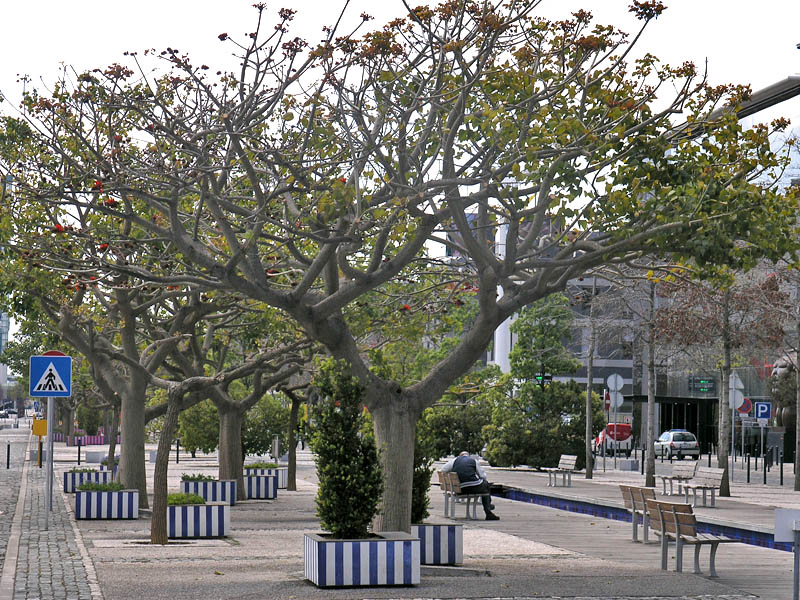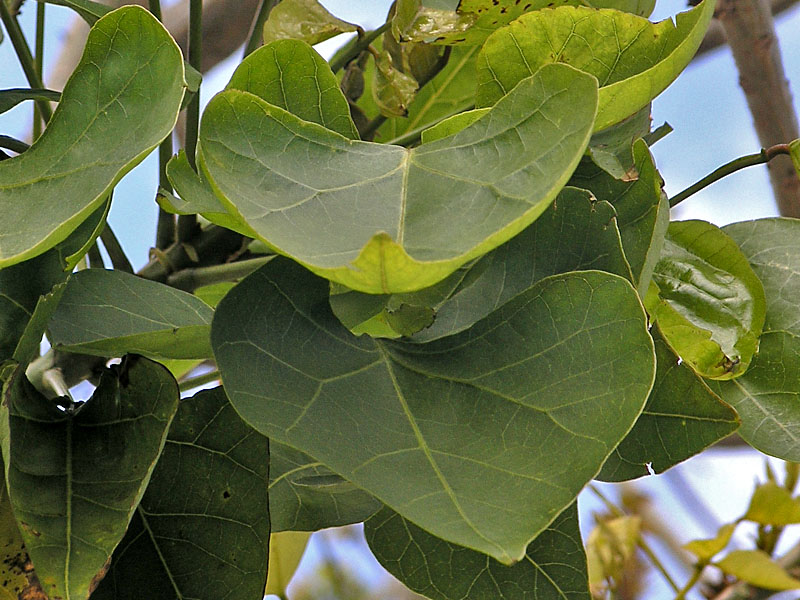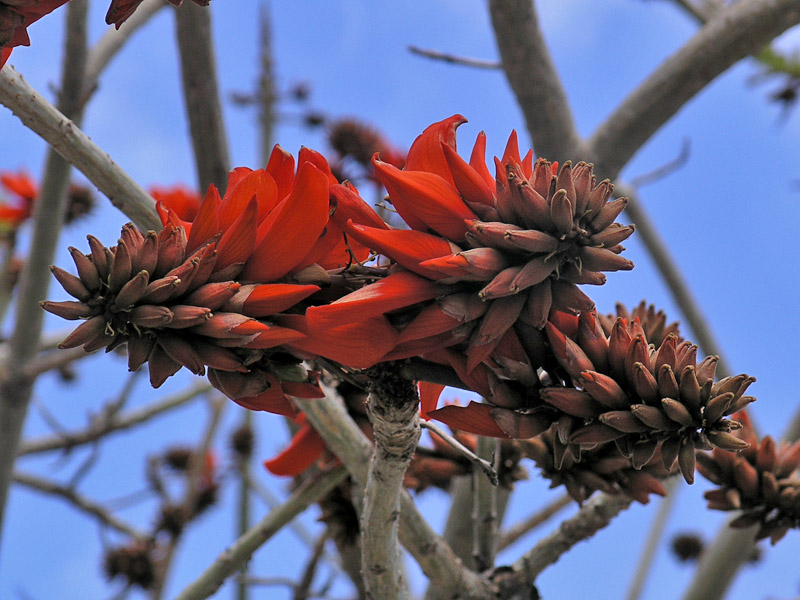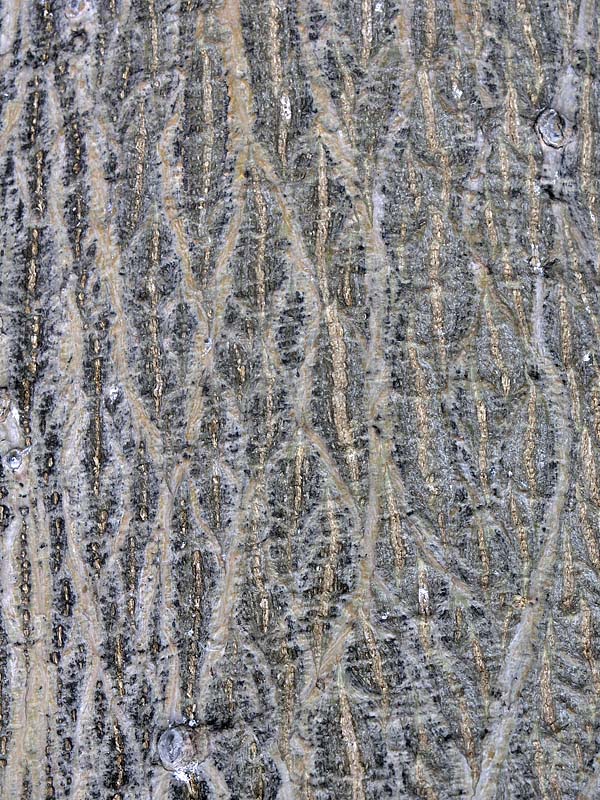
Tropicals, Woody > Erythrina > Erythrina caffra > Erythrina caffra
Erythrina caffra
Coast Coral Tree, Cape Kaffirboom, Lucky Bean Tree, Kafferboom Tree, Kuskoraalboom (Afrikaans); Umsinsi (Zulu); Umsintsi (Xhosa)
Origin: South Africa more specifically the Eastern Cape and northern KwaZulu-Natal, Thumansdorp District to Port Shepstone inland some 57 km to the Albany District of the Eastern Cape. In the north it is found in the Hlabisa and Lake Sibayi areas of Zululand where it is over 400 km away from its southern populations. Erythrina which originates from the Greek word erythros means red and alludes to the flower colour while caffra is derived from the Arabic word for 'unbeliever' in reference to the plant growing outside the old trading routes. It was given the name Erythrina caffra in 1780 by Carl Thunberg who was known as the 'father' of South African botany.
Mike's
Opinion


"
A medium to large deciduous tree native to South Africa, Erythrina caffra captures the eye with its large striking red flowers. Used in gardens, along streets or in parks it makes a wonderful addition to the landscape.
Michael Pascoe, NDP., ODH., CLT., MSc. (Plant Conservation)
"
| Family |
| Fabaceae |
| Genus |
| Erythrina |
| Species |
| caffra |
| Category |
| Tropicals, Woody |
| Type |
| Tree (deciduous) |
| Pronunciation |
| USDA Hardiness Zone |
| 9-11 |
| Canadian Hardiness Zone |
| Requires cool season protection under glass. |
| RHS Hardiness Zone |
| H2 |
| Temperature (°C) |
| -1- 4.5 |
| Temperature (°F) |
| 30-40 |
| Height |
| 9-12 m in height but can reach 20+ m in favorable conditions. |
| Spread |
| Approximately 4-8 m. |
Photographs
Description and Growing Information
Flowering Period
| General Description |
| A medium to large deciduous tree native to South Africa. It is easily recognized by its bright red or orange-red flower clusters, along with its ovate leaves and prickles on its bark. |
| Landscape |
| Today Erythrina caffra is planted in parks as well as well as a street-tree in cities and towns. |
| Cultivation |
| Tolerant of a wide variety of soil conditions once established it requires little to no supplemental irrigation. However, young plants are prone to soil borne fungal pathogens and must be provided with supplemental irrigation and grown on in well drained soil conditions while in the nursery, additionally air circulation around young plants must be positive. Prune hard after winter but not to the point of pollarding. |
| Shape |
| Upright and ovate looking and more like a shrub when young. As it matures it continues to grow upright and branches out to look more like a tree. |
| Growth |
| Fast |
| ID Characteristic |
| One of the main identification characteristics of the tree are its thorns or spines on the trunk. The leaves and flowers help differentiate it as well: large trifoliate leaves and distinct red, orange-red blooms. Following flowering cylindrical pods are produced that contain beautiful red coral beans. |
| Pests |
| It has few pest and disease problems. Some Mites such as Tydeus munsteri may cause rot diseases. Some herbivores and birds enjoy the red berries or beans which help with seed dispersal; however the thorns on the young branches may prohibit some herbivores from consuming them. The dead wood of the tree is used by borers and nesting birds, while the hallowed trunks typically have swarms of bees. Also soil-borne fungal pathogens are more susceptible in younger specimens. |
| Habitat |
| It is a subtropical tree that occurs in the warm and frost-free to light frost coastal regions of South Africa. It may be found growing in various soils from wet to well-drained, humus-rich to dry and clay type soils. |
| Bark/Stem Description |
| The bark is a light grey colour with striations running down the trunk becoming more pronounced as it matures and is covered with prickles. The wood is quire soft and decays readily, with hollow trees often inhabited by swarms of bees and bird species such as the Pied barbet and the Cardinal woodpecker. |
| Flower/Leaf Bud Description |
| The flower buds are a purplish-grey colour. |
| Leaf Description |
| As with most Erythrinas, the leaves are trifoliate with the terminal leaflet being the largest, measuring around 80 -160 x 80 -180 mm. The leaflets are deltoid with pinnate venation and an entire leaf margin. The lateral leaves are smaller and are glabrous. The petiole of the leaflets measures around 160 mm long and may be glabrous or soft. |
| Flower Description |
| Aggregate flowers, which form axillary racemes at the ends of fleshy stalks. The petals are a magnificent red to orange-red colour. Each raceme may contain up to 80 florets and measure up to 10 cm across. Flowering begins in late winter through early spring, with blooms emerging before the leaves. The flower is comprised of 5 petals, the larger, main petal curves up creating a gap, thus making the stamen visible and giving the bloom a tufted look. The individual florets contain up to 7-10 drops of nectar and are pollinated by birds such as red winged starlings, bulbuls, yellow weavers, sunbirds and orioles in addition to many other species and insects; the flowers are scentless. |
| Fruit Description |
| Dark grey-black, cylindrical pods to 65 mm long containing crimson red seed which are marked on the one side with black spots. As seeds weather and become older, they turn a rich red-brown. Many species of animals feed on the pods and seed potentially causing decreased germination. |
| Colour Description |
| Red to orange-red flowers, dark green leaves and bark that is a soft, light grey. |
| Texture Description |
| It is a coarse textured plant. |
| Notable Specimens |
| Addo Elephant National Park, Alexandria Forest, South Africa. |
| Propagation |
| Soak the seeds for 24 hours to determine which ones are viable, seeds that float could have been parasitized by insects and are thus not viable. Sow seeds in October-November, scarifying the hard seed coat to assist in germination, seed should be sown 2-3 cm apart and about 3 mm deep. Seed and seedlings must be kept well watered and ventilated and away from direct sunlight, as they are prone to fungal diseases. Growing on, it is best to use a well-drained media consisting of coarse, washed river sand and some milled pine bark. Cuttings can be collected before the tree comes out of dormancy (late winter or early spring), allow the tissue to suberise for 1- 2 days before sticking in the media, inserting to about 1/3. Cuttings must be kept well watered and ventilated and away from direct sunlight. |
| Ethnobotanical Uses (Disclaimer) |
| Erythrina caffra is known to have several medicinal properties and may be used as anti-inflammatory and antibacterial or in the treatment of nervous system diseases. It also is a poison which contains paralyzing properties. The bark is generally used to treat sores, wounds, abscesses and arthritis. However, open wounds may be treated with powdered, burnt bark. Infusions of the leaves are used to treat ear aches through the application of ear drops. The hollowed trunk is used for canoes and troughs and the wood, split and tarred may be used for shingles on houses. In South Africa it is still known as the Royal tree with some tribes such as the Zulu believing that the tree possesses magical powers. Young children in South Africa still collect the red beans from the pods along the ground and call them “lucky beans”. |



